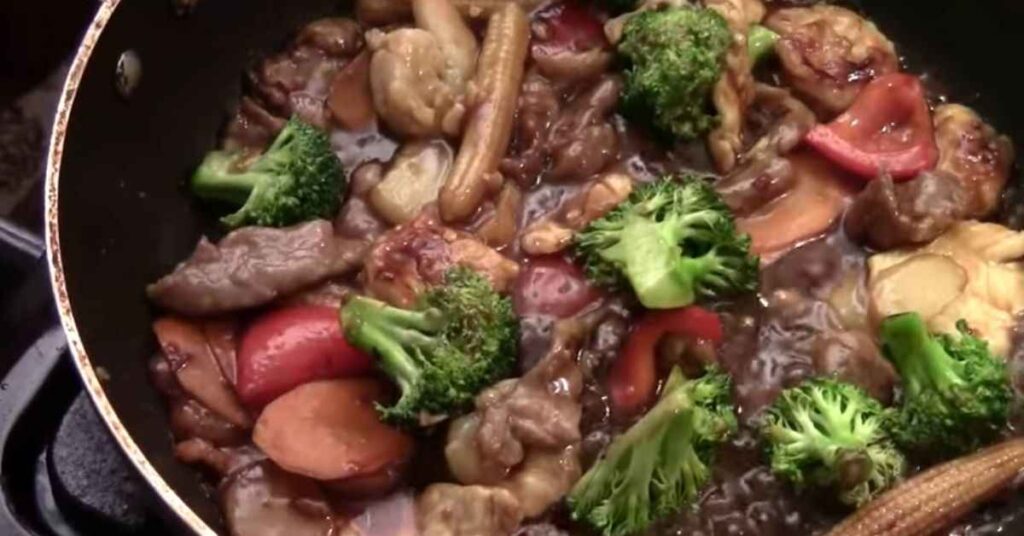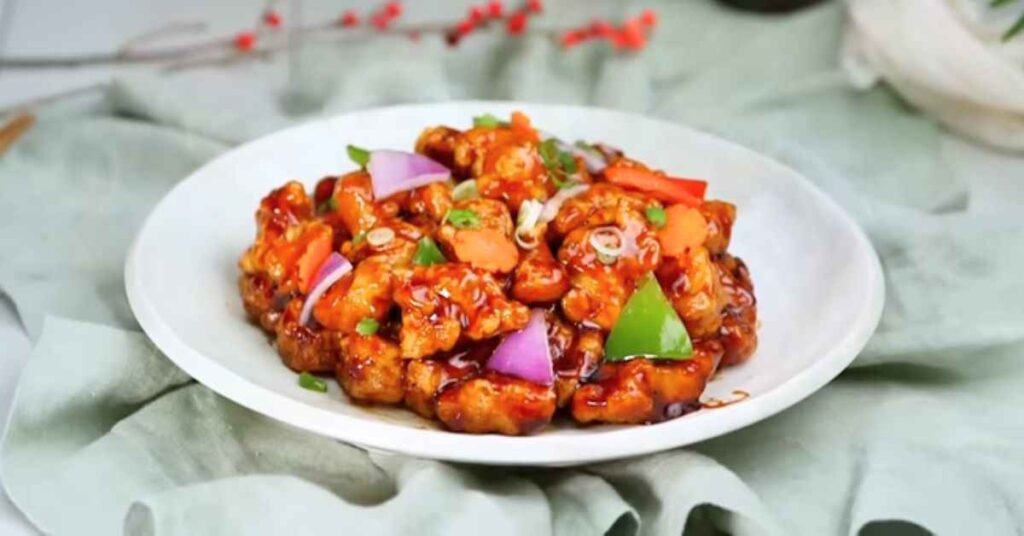Chinese cuisine is famous for its diverse flavors, aromatic spices, and artful combination of ingredients. Among the wide array of dishes, Triple Delight Chinese Food, also known as Happy Family, has become a staple in traditional Chinese and American Chinese cuisine.
This culinary treasure is not only a sensory delight but also has cultural and historical significance. In this comprehensive exploration, we’ll uncover the roots of Triple Delight, take a deep look at its cultural influences, and analyze its nutritional benefits. And will even guide you in creating your perfect presentation at home.
History and Origins of Triple Delight
The tale of Triple Delight is as rich as its flavors. This dish, as we know it today, is not so much a classic as it is a culinary concoction born from the cultural melting pot of Chinese cuisine. It likely emerged in the United States during the early 20th century, a time when a wave of Chinese migration brought new flavors to the Western palette.
Over the years, Triple Delight has been reinvented and reinterpreted, blending various culinary traditions into a single, harmonious dish that symbolizes unity and culinary innovation.

Ingredients and Preparation
Triple Delight is a dish that celebrates diversity both in its ingredients and in the flavors they impart. At its core, it features a trio of meats chicken, shrimp, and beef cooked alongside an array of colorful vegetables and a savory, glossy sauce. Each main ingredient contributes its unique texture and umami, creating a multifaceted eating experience that’s a feast for the senses.
The Meats
Each meat in Triple Delight is typically sliced thinly for quick and even cooking. The chicken is lean and delicate, the beef rich and savory, and the shrimp adds a subtle sweetness. It’s important to marinate these meats briefly in soy sauce and rice wine to infuse them with flavor and tenderize them before stir-frying.
The Vegetables
The vegetable component of Triple Delight is equally important, adding both freshness and crunch to the dish. Colorful bell peppers, earthy mushrooms, and crisp water chestnuts are common choices, but the beauty of this recipe is that you can use whatever is in your pantry. Carrots, snow peas, and baby corn are also great additions.
The Sauce
The heart of Triple Delight lies in its sauce a mixture of soy sauce, oyster sauce, rice wine, and sometimes a touch of sugar and cornstarch. This blend creates the dish’s signature sheen and depth of flavor. Adjusting the sweetness or saltiness of the sauce to your taste is the essence of customizing your own Triple Delight.
Cultural Significance
In Chinese culture, food is more than sustenance; it’s a reflection of familial bonds and community solidarity. Triple Delight embodies these values with its inclusive blend of ingredients, symbolizing the harmony that comes from unity and shared experiences around the dining table.
In many Chinese families, it’s a festive dish, often prepared for celebratory meals or during special occasions, where its rich flavors are enjoyed by the “happy family” gathered together.
Health Benefits of Triple Delight
While Triple Delight may initially seem like a decadent treat, it can also be a nutritious and balanced meal. The combination of meats and vegetables offers a range of essential nutrients, and the stir-frying method preserves more vitamins and minerals than many other forms of cooking.
To make a healthier version, consider using less oil and lean cuts of meat. Sesame oil can be used sparingly for a nutty richness without overwhelming the dish with extra fat.
Recipe Ideas and Variations
To truly make Triple Delight your own, consider these variations.
Seafood Lover’s Triple Delight
For those who favor a pescatarian approach, swap out the meats for an assortment of seafood think scallops, squid, and perhaps even some flaky white fish. The resulting dish, brimming with maritime flavors, will provide a fresh twist on the classic.
Vegan Triple Delight
With a little creativity, even a plant-based version of Triple Delight is possible. Substitute the meats with tofu, tempeh, or seitan, and bulk up the vegetable component with hearty greens like kale or bok choy.
Spicy Triple Delight
To add a kick to your dish, consider including a generous amount of chili peppers. Whether you go with the mild fruity notes of red fresnos or the searing heat of Thai bird’s eye chilis, the spice will certainly liven up the meal.
Cooking Your Triple Delight Chinese Food
Ready to try your hand at creating this beloved Chinese American dish? Follow this simple guide to prepare Triple Delight in your kitchen.
Ingredients
- 8 ounces of chicken breast, thinly sliced
- 8 ounces of beef sirloin, thinly sliced
- 8 ounces of peeled and deveined shrimp
- 1 cup of sliced bell peppers (a mix of colors adds vibrancy)
- 1 cup of sliced white onion
- 1 cup of sliced mushrooms
- 1 cup of sliced water chestnuts
- 2 tablespoons of soy sauce
- 1 tablespoon of oyster sauce
- 1 teaspoon of cornstarch
- 2 teaspoons of sugar
- 1/2 cup of chicken broth
- 3 tablespoons of vegetable oil
- 2 cloves of garlic, minced
- Salt and pepper to taste
Instructions
- Marinate the Meats: In separate bowls, marinate the chicken, beef, and shrimp with soy sauce, a splash of rice wine, and a pinch of cornstarch. Refrigerate for at least 15 minutes.
- Prepare the Sauce: In a small bowl, combine the soy sauce, oyster sauce, sugar, and cornstarch. Whisk in the chicken broth until smooth.
- Stir-Fry the Ingredients: Heat a large wok or skillet over high heat. Add the oil, then the garlic. Stir-fry for 30 seconds or until fragrant.
- Cook the Meats: Add the marinated chicken and stir-fry until no longer pink. Push to the side of the wok and repeat with the beef and shrimp.
- Add the Vegetables: Add the bell peppers, onions, mushrooms, and water chestnuts. Stir-fry until the vegetables are tender crisp.
- Combine and Serve: Return the meats to the wok. Pour in the sauce and stir to combine everything. Cook for another minute until the sauce thickens and coats the ingredients.
- Serve Hot: Adjust the seasoning with salt and pepper as needed. Serve your Triple Delight over steamed rice and enjoy.
FAQs About Triple Delight
What is the significance of the “triple” in Triple Delight?
The number three holds cultural importance in China, representing harmony and wholeness. By featuring three main ingredients, Triple Delight signifies a complete and balanced dish, fitting for gatherings and celebrations.
Can I use different vegetables in Triple Delight?
Absolutely! Triple Delight is incredibly versatile. Feel free to experiment with any vegetables you love or have on hand. Just be mindful of cooking times to ensure all components are perfectly cooked.
Why is Triple Delight also known as Happy Family?
In Chinese, “happy family” is “fu rong” (福容), and “fu” (福) symbolizes good fortune and happiness. Thus, when all the components of this dish are combined, it is considered a symbol of a happy and prosperous family life.
Conclusion
Triple Delight Chinese food is more than just a menu item it’s a story of culinary fusion, cultural representation, and the joy of sharing a delicious meal with loved ones. By understanding the roots of this dish, its symbolic value, and the way it has evolved, we can appreciate it on a deeper level.
Whether you savor it at your favorite Chinese eatery or take the time to craft it at home, Triple Delight stands as a testament to the power of food to unite and nourish.
